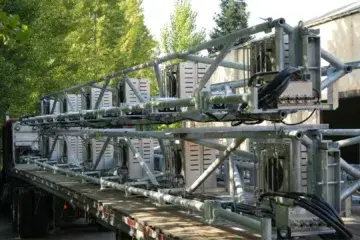New York City is seen as the financial capital of the world, and most historians believe that a huge factor in the rise of The Big Apple is down to the 363 mile connection between The Great Lakes and the Atlantic Ocean known as the Erie Canal.
By reducing transport costs by 95%, it revolutionised the way the United States in the 19th Century did business – but it also has unintended consequences. The Erie Canal connected not just people and goods, but also watersheds. The Erie Canal created a man-made connection between two different water systems, the Great Lakes and the New York River System – and in the 21st century, this is leading to huge issues when tackling the spread of invasive species such as Bighead, Grass, Black and Silver carp.
In an article written back in January, the Erie Canal was described as a potential ‘invasive species superhighway’ allowing quick travel from one watershed to another.
There are now calls to once again separate these two water systems to help stop invasive carp from reaching the Erie Canal from the Great Lakes, which is connected to the Mississippi Basin.
Dividing the Connection
The Mississippi Basin is a wide ranging river system where invasive species already have a strong presence and there are two major points where invasive carp can cross the watershed from and to the Great Lakes, one is the Chicago Area Waterways System (CAWS) and the other is the Erie Canal Corridor (ECC).
At the moment there are multiple barriers in place at one location on the CAWS with others planned at Brandon Road Lock. There are currently no barriers on the Erie Canal but some are in discussion.
One solution being touted to stop invasive carp entering different watersheds is full hydrological separation, where the watersheds are physically separated but this is seen as unfeasible and organisations such as PRISM and the Erie Canal Task Force are looking at alternatives.
A different strategy
Released in January 2020 a report produced by the Erie Canal Task Forces entitled “Erie Canal Aquatic Invasive Deterrent Study” evaluated six different mitigation strategies. Of those six strategies, the consultants recommended Alternative 2, which focused on dividing the watershed..
Alternative 2 aims to stop invasive carp from the great lakes entering the ECC watershed by installing barriers at 4 locations.
- Hydrological separation at Rome, New York
- A Boat Lift at Oswego, New York
- Hydrological Separation at Rochester, New York
- A BioAcoustic Fish Fence (BAFF) at Lockport, New York
BioAcoustic Fish Fence at the ‘front door.’
The BAFF in Lockport would separate the watershed between the Erie Canal and Lake Erie.
The system is already being tested in real-world conditions at a 3 year trial at Barkley Lock, Kentucky, and has shown very promising results.
The BAFF system combines repellent sound signals with an air bubble curtain. Sound Projectors are mounted on a chassis in sections, along with bubble pipes, and these sections are lowered to the river bed.
Once connected, they form a barrier of sound and air that can be used to guide the fish to where they can be harvested from the river, and yet still allow vessels to freely pass by.Fish Guidance System is working with federal, state and local stakeholders to tackle the issues on both sides of the watershed. If you would like further information, or to help tackle this issue, please contact us at [email protected]


